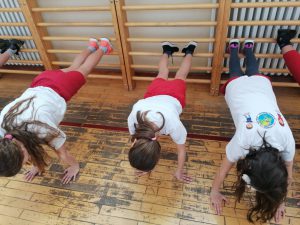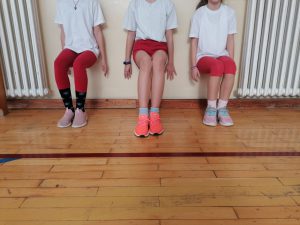Our physical activities
How did we choose physical activities?
If we want a child to be healthy, apart from sleep and food, he/she must have at least some kind of physical activity. First, children ages 5 to 17 should get at least 60 minutes of moderate to vigorous activity during the day (HEPA recommendations of WHO). This means that they should spend at least an hour a day in activities that will speed up their breathing (e.g., fast walking, slower or faster running, jumping, skipping, climbing, faster dancing, some sports game or other moving game, etc.). Second, apart from activities that make them breathe faster, at least three times a week they should have activities to strengthen their muscles (e.g., squats, climbing, walking on all fours, push-ups, plank, etc.). Thirdly, they should also learn some skills (jumping the rope, guiding the ball with the hand and foot, bouncing the ball with the racket, skating, skiing, etc.), which develop their brain as well as their body.
Physical activities in all classes
Bearing in mind that all students aged 7 to 11 have 4 to 5 lessons every weekday, we have introduced 2 minutes of the physical exercise for our students at the beginning of each lesson. In those 2 minutes, the students in one class do exercises that will make them breathe faster (running on their toes or low jumps on their toes), and the next time they do strength exercises (squats and standing with their hands on the table, alternately raising the bent leg to the chest ). Just 2 minutes of these activities give children 8 to 10 minutes of additional physical activity per day. In addition, students will be reminded 4 to 5 times a day what type of physical activity is important, and on their fitness bracelets obtained as part of the project, they will monitor indicators of their physical engagement (number of steps, heart rate, time spent in moderate to vigorous physical activity).
Physical activities in PE lessons
In PE lessons students warm up for 5 minutes by jogging or brisk walking in order to reach a pulse of 130 or more heart beats per minute. They monitor it on their fitness bracelets. Another activity in the class is learning different ways of jumping rope for 10 minutes. The third activity is strength exercises: squat with your back against a wall and hold on your hands while your feet are resting on an elevated surface. In these two exercises, students should maintain the given position for as long as possible, and in the following period they have the opportunity to break their own record. The fourth activity is a tag game, in which two students are chasing others with different ways of moving, and the others run away in the same way. When someone is caught, that child must do exercises for at least 30 seconds in place, which will increase his or her heart rate to at least 130 beats per minute. If he fails to do so in 30 seconds, he or she continues to exercise until achieving it, after which he or she can participate in the game again. At the end of the lesson, students do the fifth activity: stretching all the muscles that were active.
Physical activities outside the school
Out-of-school students should continue to learn different ways of jumping rope, trying to break their own squat and handstand records (explained above). In addition, on their fitness watches, they should monitor whether they had more than 10,000 steps during each day and/or whether they had at least 60 minutes of moderate to vigorous physical activity, by being engaged in physical activities that they like (brisk walking, running, cycling, rollerblading, playing football, basketball and various other activities).
Content
- The first action of cleaning parks and schoolyards and recycling collected waste
- The action of creating shelters for animals during the Winter
- Action of giving away bags and informing neighbours about the risks of using plastic
- Making board games from recycled materials
- Creation and positioning of the recycling bins for paper, metal, and plastic
- Making our own compost














